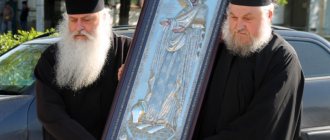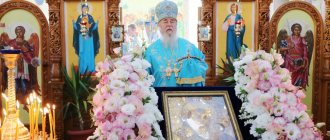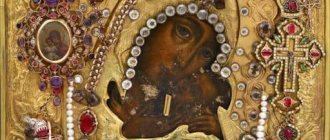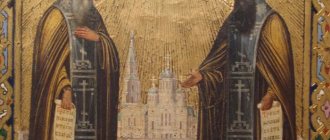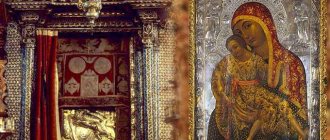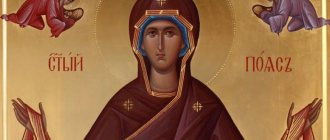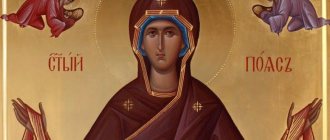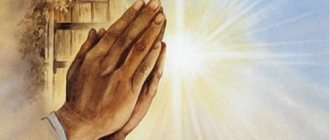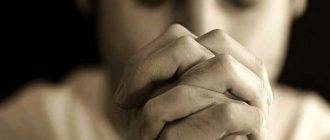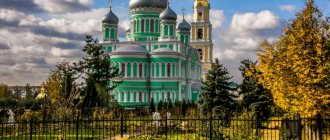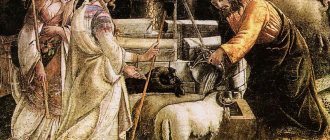"Save me, God!".
Thank you for visiting our website, before you start studying the information, please subscribe to our Orthodox community on Instagram, Lord, Save and Preserve † - https://www.instagram.com/spasi.gospodi/. The community has more than 60,000 subscribers. There are many of us like-minded people and we are growing quickly, we post prayers, sayings of saints, prayer requests, and timely post useful information about holidays and Orthodox events... Subscribe. Guardian Angel to you!
Sometimes believers are interested in the question: “What does the Triflant icon mean?” And this is not surprising. After all, this is one of the most mysterious and interesting icons in Orthodoxy. She captivates not only with her external image, but also with the meaning that she carries. It is about this miracle of Christian culture that you can learn from our article.
Iconography
The appearance of new iconographic images arouses interest among believers: what does it mean, what kind of prayer can be addressed. “The Triflant” is a little-used, and therefore little-known, holy image. On the icon under this name, believers see a little girl holding a white lily in her hands. Her clothing is a blue tunic. Long brown hair loose. A snow-white flower in children's hands symbolizes purity. The blue color of the robe is purity. The fact that this is a holy image is evidenced by the halo above the head and the inscription “Thrilling”.
The icon depicts the Mother of God as a child. The name “Three-year-old” is taken from the third song of the second canon, dedicated to the Presentation of three-year-old Mary into the temple by her parents Anna and Joachim.
Virgin Mary and her earthly journey
The Blessed Virgin Mary was a girl from Nazareth. The story of her conception of her Son is amazing. Without the participation of an earthly man, through the Holy Spirit, a new life was born in her womb. Thus, the Blessed Virgin became the mother of Jesus Christ. She is one of the most revered saints in the Christian religion. All believers worship the image of the Mother of God depicted on icons. There are hundreds of them in Christian churches. Some of them are more common, such as Kazanskaya or Iverskaya, but few have heard of others. The latter includes the Triflant icon.
History of appearance
There are 2 versions of the appearance of a new image of the Virgin Mary. According to the first, the icon was painted in the 2000s in a convent of the Rivne diocese. The basis for the image was an old postcard (or photograph) brought from Jerusalem by a nun.
The abbess of the monastery was filled with reverence for the image and decided to use it to create a new holy image of the Mother of God as a child. With her blessing, the icon was copied from a postcard with a halo and an inscription. According to the second version, the image was created by a Catholic icon painter, as it corresponds to the style of Catholic iconography.
Opinions of clergy on the Triflant icon
Church ministers have ambivalent views on this image. It is clear that the Triflant is absent from the iconography and cannot be considered an Orthodox icon. However, many parishioners are interested in how they should feel about this image, if it was given to them, for example, or they simply really like it. Should you keep it at home or not? Many priests are inclined to believe that there is nothing unequivocally wrong with this image, so they cannot prohibit keeping the Triflant icon at home. But they advise treating it as such. The clergy propose to consider it as an artistic illustration of the events of those days, and they see nothing wrong with this. However, they still advise praying in front of icons, which are accepted and distributed in all Orthodox churches.
Meaning in Orthodoxy
In Orthodox iconography, a similar style is not used, although Western iconography had a great influence on its formation. The priority of Orthodox iconography is the spiritual essence of the image, through which its closeness to God is visible. Therefore, Orthodox images are distinguished by the conventionality of their depiction, with strict adherence to the canons of plot (compliance with biblical texts) and design.
In Catholic iconography there is an artistic element that allows deviations from the Gospel. For example, on the icon of the Holy Family, Joseph the Betrothed is depicted as a young man, while he was an 80-year-old man. Joseph was the guardian of Mary's purity and virginity. The image of a young man next to the Virgin Mary distorts the biblical essence. An ignorant person will consider the Betrothed to be the father of the baby Jesus.
There are both supporters and opponents of the new holy image. To prove the holiness of the image, they provide information that, firstly, it was painted with a blessing, and secondly, the Feast of the Entry into the Temple is celebrated in the Russian Orthodox Church.
From the biography of the Blessed Virgin it is known that she was born to the elderly Anna and Joachim at the behest of the Lord, which an angel of God warned them about. The mother made a vow to give the child (son or daughter) as a gift to the Lord for eternal service. When Maria was 3 years old, her parents took her to the temple. According to the apocrypha, the future Mother of God was met at the entrance by the high priest Zacharias, the father of John the Baptist.
Anna placed her daughter on the first step of the stairs leading to the temple. Maria, without looking back, ran upstairs to Zechariah, quickly covering 15 steps. She lived at the temple for up to 12 (according to other sources - 14) years. Here she was taught the Holy Scriptures and handicrafts.
From an early age, the girl was distinguished by her responsiveness to human suffering and special spiritual strength. Daily prayers strengthened her spirit and faith in the Lord. At the age of 12 (14), by command of the Lord, she was given in marriage to Joseph the Betrothed. The Entry into the Temple of the Blessed Virgin is included in the list of the twenty most significant Orthodox holidays. In honor of this celebration, the Russian Orthodox Church has consecrated churches called Vvedensky.
For opponents of the newly appeared holy image, the main arguments are:
- violation of the canonical style in the image;
- a ban on female monastics performing the sacraments, that is, the blessing of the abbess has no significance for the consecration of the icon;
- the child is not wearing a headdress.
In canonical Orthodox iconographic images, the parents and the high priest are present next to the girl; a temple and a staircase are visible. The child’s figurine differs from the adults standing next to it only in size. Mary is wearing the traditional outfit of an adult married woman: a veil covering her from head to ground (maforium).
Based on such differences, the majority of the Orthodox clergy believes that this is an artistic depiction of a plot from Holy Scripture, close to the Catholic style.
Catholic iconography is characterized by a free interpretation of evangelical stories. The faces of saints, angels, the Mother of God, and Jesus Christ are similar in execution to paintings. They can be used to judge the emotional state of the characters.
Paintings on biblical themes by Western artists are difficult to distinguish from iconographic images. For example, Titian’s painting “The Presentation of the Blessed Virgin Mary into the Temple,” stored in an art gallery in Venice. The artist depicted Mary on the stairs, dressed in a blue dress, with her head uncovered.
Admirers of the spiritualized image of the little Virgin Mary remind us as a counter-argument that the canonical images of the Mother of God “Seeking the Lost,” “Akhtyrskaya,” and “Helper in Childbirth” do not have an omophorion (headscarf). The color scheme (white-blue-brown) of the icon is traditional for Orthodox icon painting.
The meaning of an icon is determined by the attitude of a believer towards it, the presence of sincere faith. Prayers before the holy image of the Triflant have helped many people find hope and resolve issues of raising children. The novelty of the image does not detract from its Christian significance.
The clergy treat the childish image of the Virgin Mary with restraint. The Russian Orthodox Church has about 800 holy images of the Heavenly Queen, created in Orthodox traditions to create a prayerful mood. According to the clergy, these images have a history of appearance, consecration. The sight of a little girl on an icon rather evokes tenderness, without promoting spiritual communication with God.
How the shrine helps believers
Most of all, the icon “Fadeless Color” is revered by representatives of the fair sex. Orthodox youths and men also pray to her.
The image of the Mother of God helps:
- find a harmonious family;
- become happy parents;
- survive difficult periods, disagreements;
- stop quarrels, conflicts at home or at work;
- regain the lost joy of life;
- get rid of melancholy, apathy;
- cleanse and heal the soul;
- learn wisdom, patience, mercy;
- strengthen lost faith.
This face has long been a symbol of sinlessness, spiritual and physical purity. That is why young girls who want to remain chaste until marriage pray in front of the icon. You can contact the icon at any time, and always on the day of its celebration.
Orthodox people believe: the painting “Unfading Color”, present in the home iconostasis, helps young girls get married, find their true love, protects them from temptations and mistakes on the way to finding family happiness. With the icon you can share your hopes, dreams or fears, make sincere requests: the Mother of God will always hear a prayer for marriage or another request and will definitely help a pure soul.
“Fadeless color” is often used to bless future spouses for a happy family life and the birth of healthy offspring. The image of the Virgin Mary patronizes the already created hearth, so they pray to him for the preservation of the family. It is believed that the heavenly intercession of the Mother of God protects the union of people who love each other from many troubles and gives strength to jointly overcome the challenges that arise.
The icon also helps to prolong spiritual and physical youth and strengthen physical health. They pray to her for beauty, for the ability to conceive and bear a child. The Mother of God saves from physical and mental illnesses, supports Christians who have had to endure persecution, injustice, loneliness and other misfortunes.
Reverence
The icon is not included in the list of the church calendar and has no official recognition, therefore there is no established day for venerating the image. Believers turn to the image on days of commemoration of other icons of the Most Holy Mother, on the feast of the Entry into the Temple of the Lord.
A ban on its use and sale in churches was imposed in one diocese: Novokuznetsk. The reason for the ban is Catholic symbolism. It is not accepted in other dioceses.
The prototype “Thrilling” is located in the Holy Trinity Derman Convent in the city of Rivne. Lists of icons are common among Orthodox believers and are used for cell prayers.
What do they pray for in front of the holy image?
Orthodox Christians do not spend a single day without prayer to the Mother of God. In any house where baptized people live, you can see at least one icon of the Virgin Mary. What do they pray for in front of the Triflant icon? She is especially revered by those women who have recently learned the joy of motherhood. But it consists not only of positive things, it is, first of all, numerous concerns, concern about the health of your child.
A small child cannot say what is bothering him, he does not understand the meaning of words, and he cannot take care of himself. Therefore, I especially want to protect him from any troubles. It is next to the crib that mothers try to place the icon of the young Mother of God, hoping that She will protect the baby. Such an act is quite understandable, although it does not fit into church canons. An icon is not a talisman; it should be placed on a wall or on a shelf with other shrines.
The size of the image and the technique of its execution can be any. Today, the Triflant icon is available on paper, wood, hand-painted, embroidered with thread or beads. You can take your purchase to the temple for consecration. But the main thing that sanctifies the life of a family is heartfelt prayer, kindness to each other, and patience. A woman should take care of all this, then God’s protection will accompany all her affairs.
About the author About the book
